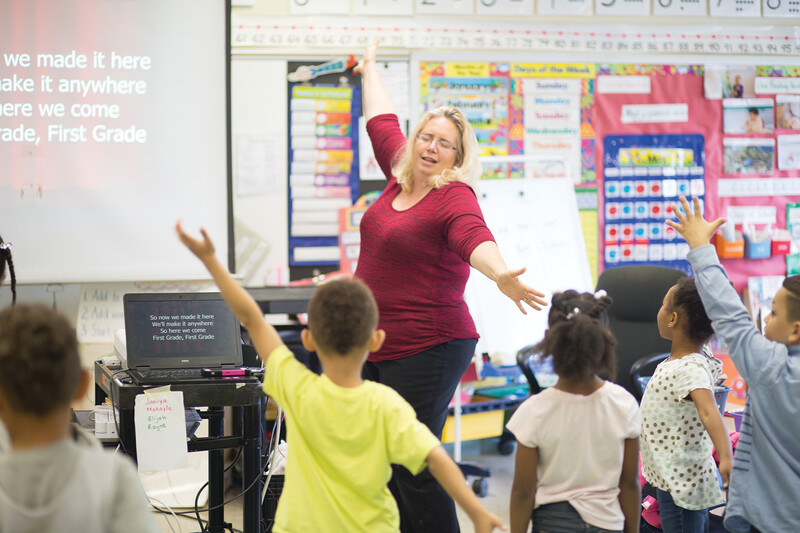We educators are directly responsible for crucial, life-saving work. Today, a student who graduates from school with a mastery of essential skills and knowledge has a good chance of successfully competing in the global market place, with numerous opportunities to lead a rewarding adult life. In stark contrast, students who fail in school are at greater risk of poverty, welfare dependency, incarceration, and early death. With such high stakes, educators today are like tightrope walkers without a safety net, responsible for meeting the needs of every student, with little room for error. Fortunately, compelling evidence shows that Response to Intervention (RTI) is our best hope for giving every student the additional time and support needed to learn at high levels (Burns, Appleton, & Stehouwer, 2005).
RTI's underlying premise is that schools should not wait until students fall far enough behind to qualify for special education to provide them with the help they need. Instead, schools should provide targeted and systematic interventions to all students as soon as they demonstrate the need. From one-room schoolhouses on the frozen tundra of Alaska to large urban secondary schools, hundreds of schools across the United States are validating the potential of these proven practices.
In light of this fact, why are so many schools and districts struggling to reap the benefits of RTI? Some schools mistakenly view RTI as merely a new way to qualify students for special education, focusing their efforts on trying a few token regular education interventions before referring struggling students for traditional special education testing and placement. Others are implementing RTI from a compliance perspective, doing just enough to meet mandates and stay legal. For still others, their RTI efforts are driven by a desire to raise test scores, which too often leads to practices that are counter productive to the guiding principles of RTI. Far too many schools find the cultural beliefs and essential practices of RTI such a radical departure from how schools have functioned for the past century that they are uncomfortable and unwilling to commit to the level of change necessary to succeed. Finally, some schools refuse to take responsibility for student learning, instead opting to blame kids, parents, lack of funding, or society in general for students' failures.
Although the specific obstacles vary, the underlying cause of the problem is the same: Too many schools have failed to develop the correct thinking about Response to Intervention. This has led them to implement some of the right practices for the wrong reasons.
The Wrong Questions
The questions an organization tries to answer guide and shape that organization's thinking. Unfortunately, far too many schools and districts are asking the wrong questions, like these.
How do we raise our test scores?
Although high-stakes testing is an undeniable reality in public education, this is a fatally flawed initial question that can lead to incorrect thinking. For example, many districts that focus first on raising test scores have concluded that they need strictly enforced pacing guides for each course to ensure that teachers are teaching all required state standards before the high-stakes state tests. Usually, these guides determine exactly how many days each teacher has to teach a specific standard. Such thinking makes total sense if the goal is to teach all the material before the state assessments, but it makes no sense if the goal is to have all students learn essential standards. This in itself is problematic because, as Marzano (2001) notes, "The sheer number of standards is the biggest impediment to implementing standards" (p. 15). Assigning arbitrary, pre-determined amounts of time to specific learning outcomes guarantees that students who need additional time to learn will be left in the wake as the teacher races to cover the material.
This faulty thinking also leads to misguided intervention decisions, such as focusing school resources primarily on the "bubble kids" who are slightly below proficient. Administrators who adopt this policy conclude that if these students can improve, the school's test scores will likely make a substantial short-term jump. Consequently, the students far below basic often receive less help. This is deemed acceptable, as the primary goal of the school is to make adequate yearly progress, and the lowest learners are so far behind that providing them intensive resources will likely not bring about immediate gains in the school's state assessment rankings.
How do we "implement" RTI?
Frequently, we have worked with schools that view RTI as a mandated program that they must "implement." Consequently, they create an abundance of implementation checklists and time lines. Like obedient soldiers, site educators take their RTI marching orders and begin to complete the items on their RTI to-do list, such as administering a universal screening assessment, regrouping students in tiered groups, or creating a tutorial period.
Such an approach is fraught with pitfalls. First, it tends to reduce RTI to single actions to accomplish, instead of ongoing processes to improve teaching and learning. In addition, this approach fails to understand that what we ask educators to "do" in RTI are not ends in themselves, but means to an end. In other words, a school's goal should not be to administer a universal screening assessment in reading but to ensure that all students are able to read proficiently. To achieve this goal, it would be essential to start by measuring each student's current reading level, thus providing vital information to identify at-risk students and differentiate initial instruction.
How do we stay legal?
Because RTI was part of the reauthorization of the Individuals with Disabilities Education Improvement Act (IDEIA) in 2004, many schools view its implementation from the perspective of legal compliance. This concern is understandable, as special education is by far the most litigated element of public education, and the potential costs of being out of compliance or losing a fair hearing can cripple a district.
Unfortunately, a large number of schools and districts are making RTI unreasonably burdensome. We find many districts creating unnecessarily complicated, laborious documentation processes for every level of student intervention, in fear that the data may be needed someday if a specific student requires special education services.
Teachers tell us that they often decide against recommending students for interventions "because it's not worth the paperwork." Other teachers complain that they "hate" RTI because they spend more time filling out forms than working with at-risk students. We have also worked with districts that refuse to begin implementing RTI until there is a greater depth of legal interpretation and case precedent; all the while, their traditional special education services are achieving woefully insufficient results in student learning.
If there is one thing that traditional special education has taught us, it's that staying compliant does not necessarily lead to improved student learning—in fact, the opposite is more often the case. Since the creation of special education in 1975, we have spent billions of dollars and millions of hours on special education—making sure we meet time lines, fill out the correct forms, check the correct boxes, and secure the proper signatures. A vast majority of schools are compliant, but are students learning?
In the United States, the special education redesignation rate (the rate at which students have exited special education and returned to general education) is only 4 percent (U.S. Department of Education, 1996).
According to the U.S. Department of Education, the graduation rate of students with special needs is 57 percent (National Center on Secondary Education and Transition [NCSET], 2006).
It is estimated that up to 50 percent of the U.S. prison population were identified as students with special needs in school (NCSET, 2006).
There is little evidence to suggest that greater levels of legal compliance lead to greater levels of learning. If schools or districts would like to stay legal, they should start by focusing on student learning; parents rarely file for a fair hearing because their child is learning too much.
What's wrong with this kid?
At most schools, when a student struggles in the regular education program, the school's first systematic response is to refer the student for special education testing. Traditionally, schools have believed that "failure to succeed in a general education program meant the student must, therefore, have a disability" (Prasse, 2009). Rarely does special education testing assess the effectiveness and quality of the teaching that the student has received.
RTI is built on a polar opposite approach: When a student struggles, we assume that we are not teaching him or her correctly; as a result, we turn our attention to finding better ways to meet the student's specific learning needs. Unless schools are able to move beyond this flawed question, it is unlikely that they will ever see RTI as anything more than a new way to identify students for special education.
The Right Questions
Schools cannot succeed by doing the right things for the wrong reasons. So what are the right questions that should lead our work?
What is the fundamental purpose of our school?
Our schools were not built so educators would have a place to work each day, nor do they exist so that our government officials have locations to administer high-stakes standardized tests each spring. If we peel away the various layers of local, state, and federal mandates, the core mission of every school should be to provide every student with the skills and knowledge needed to be a self-sufficient, successful adult.
Ask parents what they want school to provide their child, and it is doubtful the answer would be, "I just want my child to score proficient on state assessments," or "I want my child to master standard 2.2.3 this year." Learning specific academic standards and passing state tests are meaningless if the student does not become an intelligent, responsible adult who possesses the knowledge and quality of character to live a happy, rewarding adult life.
What knowledge and skills will our children need to be successful adults?
Gone are the days when the only skills a child needed to become a successful adult were a desire to work and some "elbow grease." Today's economy is driven by technology, innovation, and service. Because technology and human knowledge are changing at faster and faster rates, the top 10 in-demand jobs today probably didn't exist five or six years ago (Gunderson, Jones, & Scanland, 2004). Our high school graduates will most likely change careers at least four times by the age of 40—not jobs or employers, but careers. Alvin Toffler has been said to have suggested that, because of this acceleration of human knowledge, the definition of illiterate in the 21st century will not be "Can a person read and write?" but rather "Can a person learn, unlearn, and relearn?"
How do we prepare students for jobs that don't exist? How do we teach our students knowledge that we've not yet discovered? Teaching them comprehension and computation skills will not be enough—they need to be able to analyze, synthesize, evaluate, compare and contrast, and manipulate and apply information. We will erode our children's and world's future by limiting our vision to teaching only the skills and knowledge presented in our state assessments.
What must we do to make learning a reality for every student?
If we took the research on effective teaching and learning and condensed it into a simple formula for learning, it would look like this: Targeted Instruction + Time = Learning
Because learning styles and instructional needs vary from student to student, we must provide each student with targeted instruction—that is, teaching practices designed to meet his or her individual learning needs. We also know that students don't all learn at the same speed. Some will need more time to learn. That is the purpose of RTI—to systematically provide every student with the additional time and support needed to learn at high levels.
If a school has asked the right questions, then how would this new way of thinking affect a school's RTI efforts? Quite honestly, it would transform every tier.
Tier 1
In Tier 1, the school would start by ensuring that every student has access to rigorous, grade-level curriculum and highly effective initial teaching. The process of determining essential student learning outcomes would shift from trying to cover all required standards to a more narrow focus on standards that all students must master to be able to succeed in the future.
A collective response will be required to ensure that all students learn, so teacher teams would work collaboratively to define each essential standard; deconstruct the standard into discrete learning targets (determine what each student must be able to know and do to demonstrate proficiency); identify the prior skills needed to master the standard; consider how to assess students on each target; and create a scope and sequence for the learning targets that would govern their pacing. Schools may continue to use such resources as textbooks as primary Tier 1 resources, but only by selecting those sections that align to what the team of teachers has determined to be essential for all students to master.
The school would understand that differentiation for individual student needs cannot be optional at Tier 1. Whether in an elementary math lesson or a secondary social studies lesson, teachers must scaffold content, process, and product on the basis of student needs, setting aside time to meet with small groups of students to address gaps in learning.
The direct, explicit instruction model contains the structures through which differentiation can take place. This thinking contradicts the approach taken by many schools that have purchased a research-based core instructional program and dictated that this program constitutes the only instructional material that teachers can use. This quest for fidelity sometimes becomes so rigid that each teacher is required to teach the same lesson, on the same day, following the same script.
Although we agree that schools should implement scientifically research-based resources, we also know that not all students learn the same way. In addition, because not all students learn at the same speed, we would plan flexible time into our master schedule to allow for reteaching essential standards for students who require it as well as providing enrichment learning for students who have already demonstrated mastery. To achieve these collective Tier 1 outcomes, we firmly believe that the only way for an organization to successfully implement RTI practices is within the professional learning community (PLC) model (Buffum, Mattos, & Weber, 2009).
Tier 2
At Tier 2, the school would use ongoing formative assessment to identify students in need of additional support, as well as to target each student's specific learning needs. In addition, teachers would create common assessments to compare results and determine which instructional practices were most and least effective in Tier 1. Giving students more of what didn't work in Tier 1 is rarely the right intervention!
Most Tier 2 interventions would be delivered through small-group instruction using strategies that directly target a skill deficit. Research has shown that small-group instruction can be highly effective in helping students master essential learnings (D'Agostino & Murphy, 2004; Vaughn, Gersten, & Chard, 2000).
Intervention is most effective when the interventions are timely, structured, and mandatory; focused on the cause of a student's struggles rather than on a symptom (for example, a letter grade); administered by a trained professional; and part of a system that guarantees that these practices apply no matter which teacher a student is assigned to (Buffum, Mattos, & Weber, 2009). Finally, because the best intervention is prevention, the effective RTI school would use universal screening data to identify students lacking the prerequisite skills for an essential standard and then provide targeted Tier 2 or Tier 3 support before delivering core instruction on that standard.
Tier 3
At Tier 3, we would start by guaranteeing that all students in need of intensive support would receive this help in addition to core instruction—not in place of it. If our goal is to ensure that all students learn at high levels, then replacing core instruction with remedial assistance not only fails to achieve this outcome, but also tracks at-risk students into below-grade-level curriculum.
Because Tier 3 students often have multiple needs, intensive help must be individualized, based on a problem-solving approach. It is unlikely that a single program will meet the needs of a student in Tier 3, as many of these students are like knots, with multiple difficulties that tangle together to form a lump of failure. Because of this, a school focused on meeting the needs of every student would develop a problem-solving team, composed of a diverse group of education experts who can address the students' social, emotional, and learning needs. The purpose of this team would not be to determine what is wrong with the student but to identify the specific needs the student still experiences after Tier 2 intervention, quantify them, and determine how to meet them.
Schools need to deliver Tier 3 interventions with greater intensity than Tier 2 interventions. They can do this by increasing both the duration and frequency of the intervention and lowering the student–teacher ratio (Mellard, 2004). At Tier 3, it is also important to quantify the student's specific learning needs. It would not be enough to say that a student's problem is "reading." Instead, a school team might find that a 2nd grade student is reading grade-level passages at a rate of 20 words read correctly (WRC) per minute compared with the expectation of 45 WRC for 2nd grade students at that point in the school year.
If a school diligently applies these practices, a vast majority of students will never need to be referred for special education testing. When all students have guaranteed access to rigorous curriculum and effective initial teaching, targeted and timely supplemental support, and personalized intensive support from highly trained educators, few will experience failure (Sornson, Frost, & Burns, 2005). In the rare case that this level of support does not meet a specific students' needs, the student may indeed have a learning disability. In this case, special education identification would be fair and appropriate.
Although the purpose of RTI is not special education identification, a school will identify far fewer students for these services if they ask the right questions and take preventative steps. Schools that fail to do so will continue to blame students for failing, which will perpetuate the over-identification of minority, English language learning, and economically disadvantaged students into special education.
Doing the Right Work for the Right Reasons
The secret to capturing the right way of thinking about RTI comes down to answering this question: Why are we implementing Response to Intervention?
The answer lies in why we joined this profession in the first place—to help children. Our work must be driven by the knowledge that our collaborative efforts will help determine the success or failure of our students. RTI should not be a program to raise student test scores, but rather a process to realize students' hopes and dreams. It should not be a way to meet state mandates, but a means to serve humanity. Once we understand the urgency of our work and embrace this noble cause as our fundamental purpose, how could we possibly allow any student to fail?







